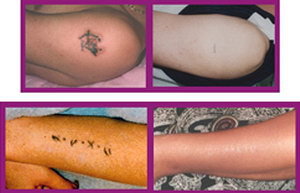Description
Please click tab to open
Asymmetrical Facial Features and Correction
As a Gauteng leading permanent makeup and paramedical specialist, we have successfully corrected many asymmetrical features including amongst others cleft lip, uneven eyebrows and one lip thicker than the other or badly scarred – giving back to our clients beautiful symmetry and boosted confidence. Paramedical micropigmentation treatments are available to both men and women of all ethnic backgrounds and deliver a highly favourable result yielding a soft natural balance – just as nature intended.
A large variety of specialised treatments are available for alopecia sufferers. Alopecia is an auto-immune disease which may negatively affect various parts of the body - from eyebrows to eyelashes and in more severe cases loss of scalp hair. Each case is treated on an individual basis and we would encourage you to feel free to contact us to discuss your particular need within our confidential and sterile environment.
Scalp Micropigmentation
In short, scalp micropigmentation is the specialised process of tattooing the scalp with tiny micro-dots in order to give the resemblance of stubble – a short buzz-cut appearance which looks best when the hair is kept very short. Warning – always ensure the person treating your scalp has sufficient experience! To the specialist practitioner, scalp micro pigmentation is essentially a simple procedure, non-invasive and there is no down time. A SMP pigment is matched to your existing hair colour (if any exists) or skin tone and a hairline is agreed upon based on where it used to be. I then add thousands of micro-dots to the scalp – focussing on the areas of thinning hair and blending seamlessly into any existing hairlines. The same process may be used to camouflage a variety of head scars. Numbing solutions are available, however, minimal pain is experienced as the pigment is placed shallow in the skin.
While this can be a time-consuming procedure, it is a truly excellent alternative – fast-growing in popularity, should available retail therapies not be working for you.
Areola Pigmentation and simulation
Restore the areola and nipple area of the breast. Where no nipple exists, a natural-looking 3D effect is achieved with specialised advanced techniques, shading and colour application. Irregular, disproportionate and fading areolas may similarly be treated – delivering an extremely successful and natural result. It is particularly rewarding to us to restore femininity and confidence back to our many brave cancer survivors. [/accordion]
Download our Areola Colour Guide
Collagen Induction Therapy AKA Microneedling
Collagen Induction Therapy (CIT) is a highly effective and safe treatment for wrinkles, scars, stretch marks and general skin rejuvenation. As one of Johannesburg’s leading specialists (three times certified), we can assist you to regain your confidence using a combination of high-tech devices.
The deeper layers of skin are gently treated by creating micro-injuries using state-of-the-art computerised micro equipment which is made up of configurations of tiny micro-needles. The micro-injuries created in turn safely triggers the body’s natural self-repair healing response mechanism (release of growth hormones). This response synthesis results in the body’s generation and building of normal and healthy collagen, elastin, fibroblasts and other structures, effectively replacing damaged tissue.
CIT is a highly effective and safe treatment for wrinkles, scars, pigmentation, stretch marks and general skin rejuvenation. When treated correctly, CIT does not pose any risk of permanent scarring. This highly specialised treatment allows specific topical active protocols to penetrate deeper into the layers of the skin to further boost results.
The result is smoother, firmer, younger looking skin. Scars experience a tissue rejuvenation response – resulting in the apparent fading of scars. In the unlikely event that a scar stubbornly remains white, the natural skin colour is matched and the pigment implanted into the upper dermal layer of the scar, thereby ‘colouring’ or camouflaging the scar and giving a more even textured appearance.
Generally a spectacular 50% average improvement is visible after just 1 treatment!
CIT is a safe and simple treatment for both women and men of all ages and ethnicities.
Tattoo Removal
The tattoo that seemed like a good idea at the time, is frequently becoming a problem and can even cause embarrassment in later life. As a twice-certified specialist, I use the latest techniques which achieve an effective, neutralised end result. Currently the most effective tattoo removal options are the chemical extraction removal products which use specific organic and/or inorganic chemical extraction techniques. The product is applied in a similar method to the original tattoo and is designed to draw the tattoo pigment out of the skin – ultimately removing the unwanted tattoo over a period of between two to six months. This is usually done over 3 to 5 treatments, spaced at eight week intervals – depending on the individual condition and size of the original tattoo. Permanent makeup is usually removed in one or two sessions.
This form of tattoo removal is highly effective and usually leaves minimal scarring (if any) and is unlike laser (which ‘reads’ limited colours) or surgical removal – which will obviously scar.
As with all of our procedures, in-depth home care instructions and post procedure care instructions will be given.
Vitiligo
Vitiligo is an auto-immune-related disease. The US-based Mayo Clinic describes Vitiligo as a pigmentation disorder in which melanocytes (the cells that make pigment or colour) in the skin are destroyed. The exact cause of vitiligo is not known, but there are several different theories. There is strong evidence that people with vitiligo inherit a group of genes that make them susceptible to depigmentation.
Vitiligo can start at any age, but most frequently appears before age 20.
Depending on the type of vitiligo you have, the discolored patches may cover:
- Many parts of your body. With this most common type, called generalized vitiligo, the discolored patches often progress similarly on corresponding body parts (symmetrically) – usually on the extremities (hands and feet) first..
- Only one side or part of your body. This type, called segmental vitiligo, tends to occur at a younger age, progress for a year or two, then stop.
- One or only a few areas of your body. This type is called localized (focal) vitiligo.
It’s difficult to predict how your disease will progress. Sometimes the patches stop forming without treatment. In most cases, pigment loss spreads and eventually involves most of your skin. Very rarely will the skin gets its color back.
This treatment aims to restore colour to skin where none exists. A corresponding pigment colour is matched to the skin colour and is then carefully implanted just into the upper dermis of the depigmented skin Caution is advised: we only work on vitiligo cases where there has been remission for 12 consecutive months – active vitiligo depigmentation may be prematurely advanced should the client not wait for the required remission period.
[gravityform id="1" name="Booking Enquiry"]




















